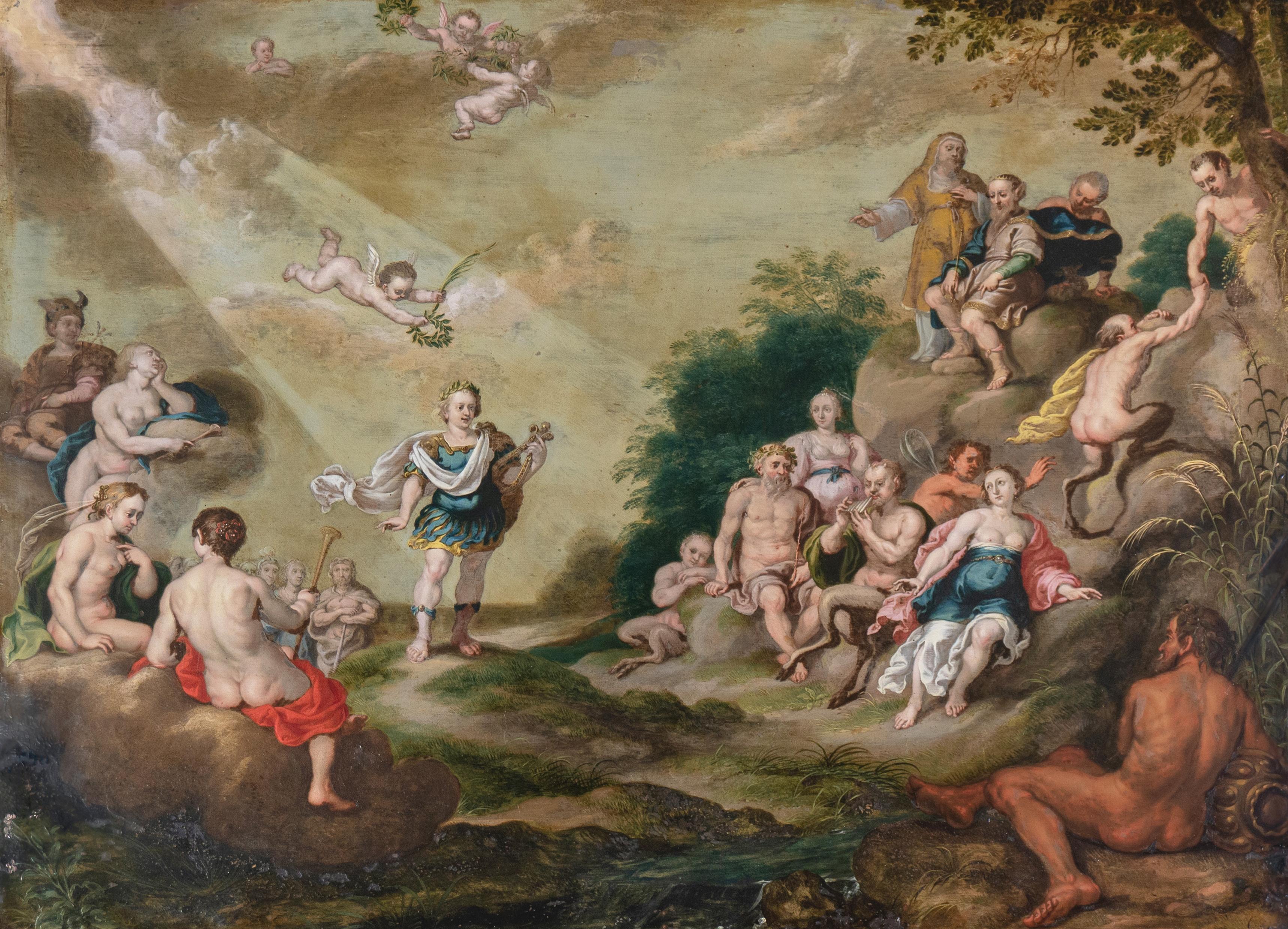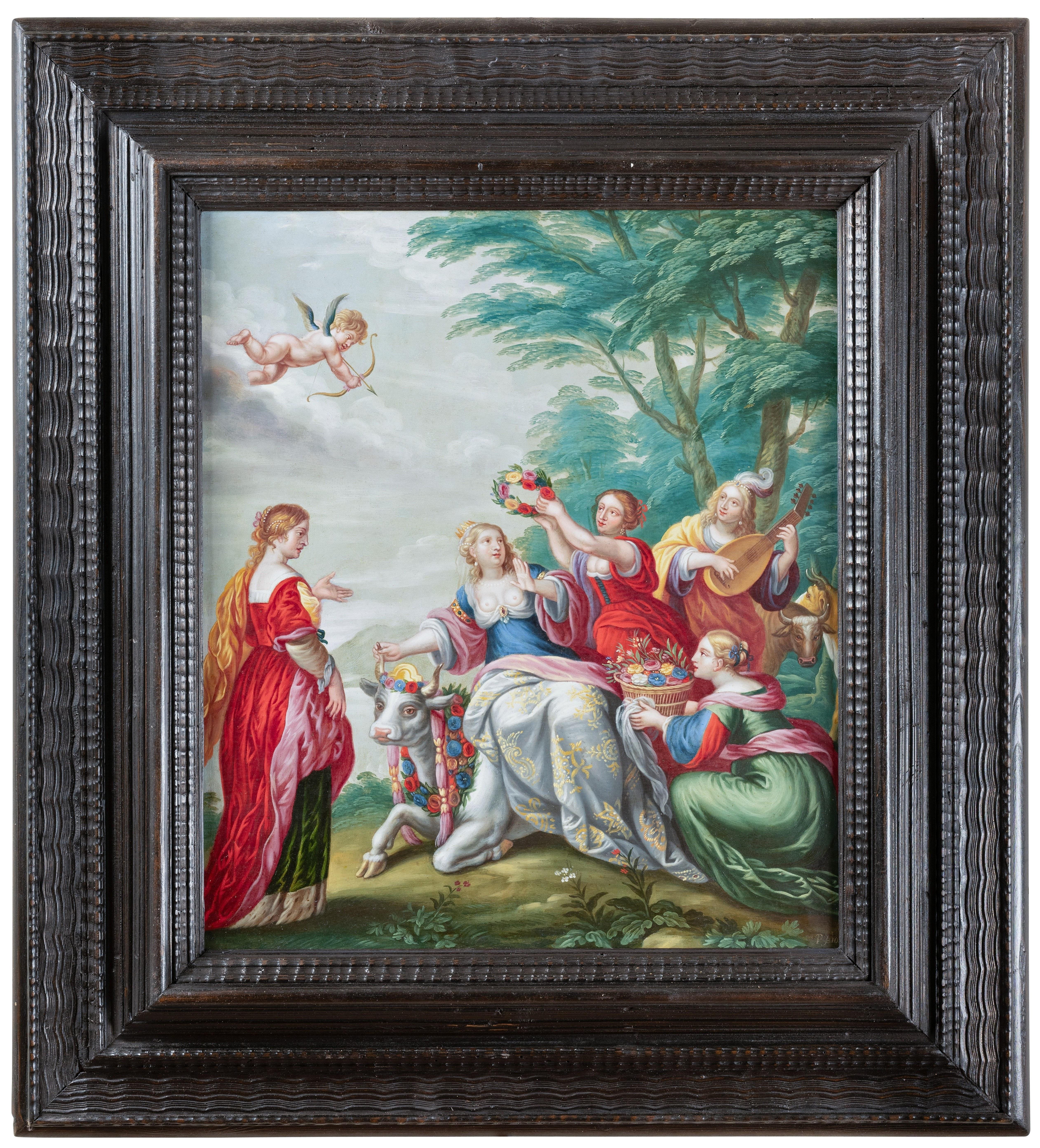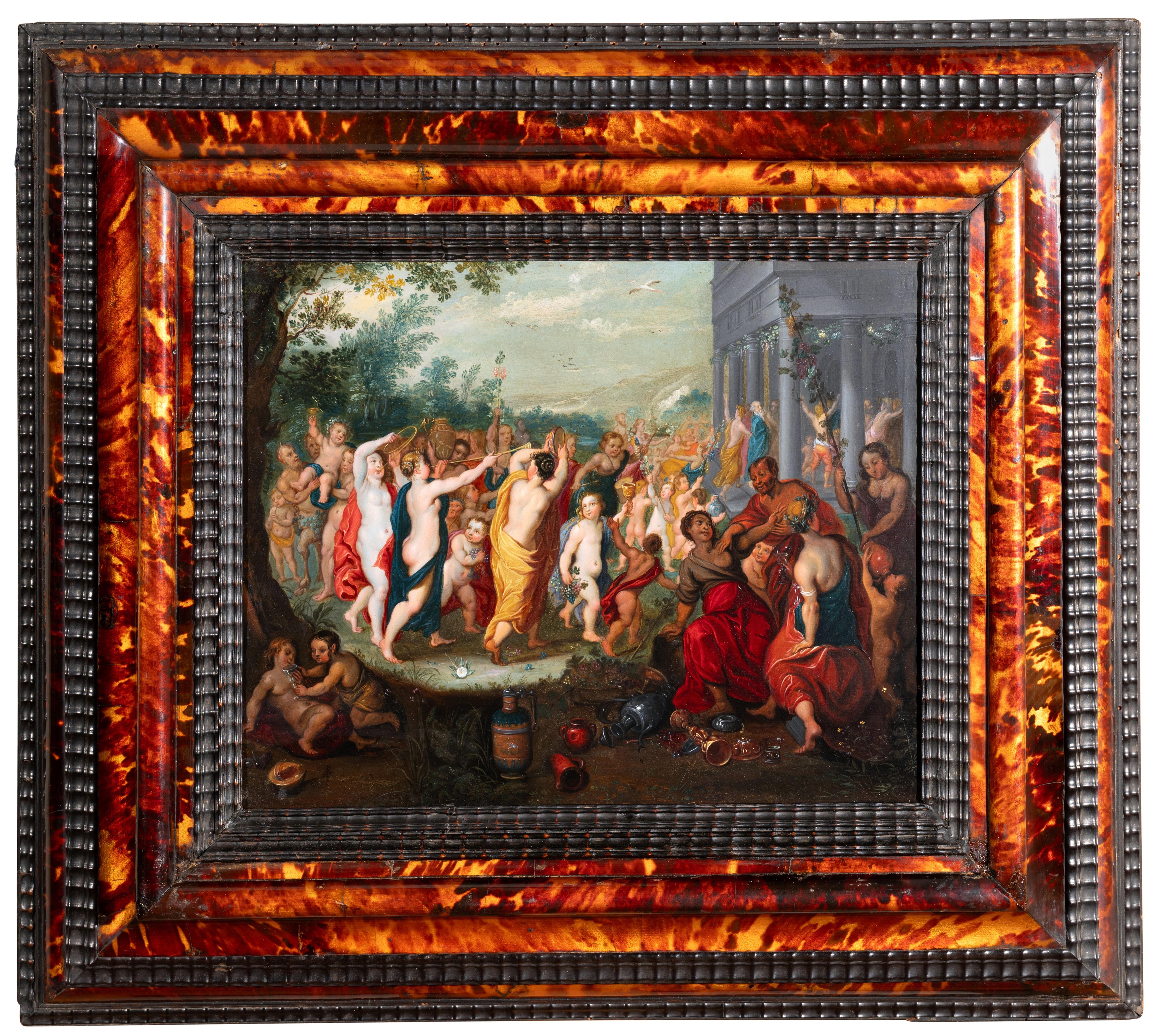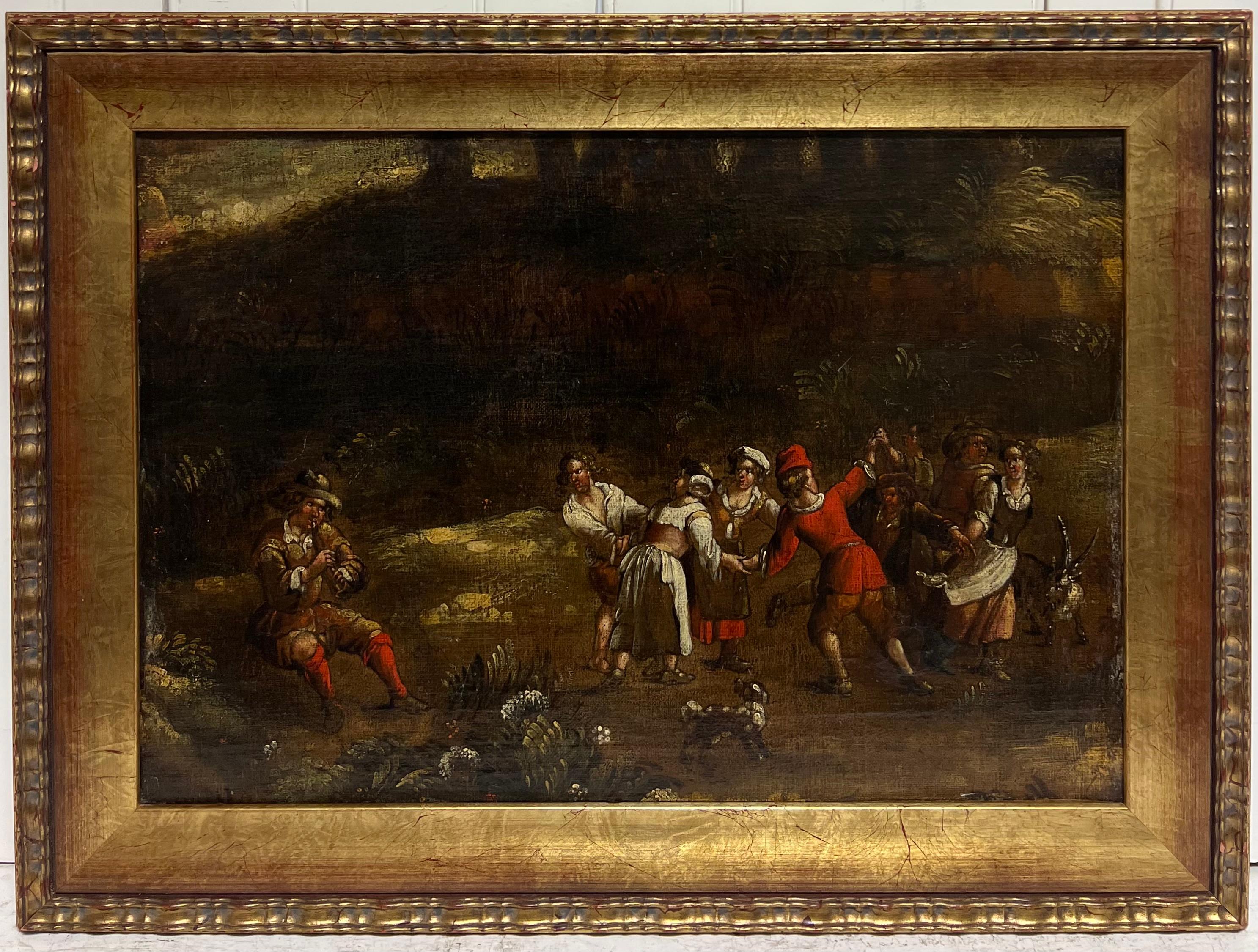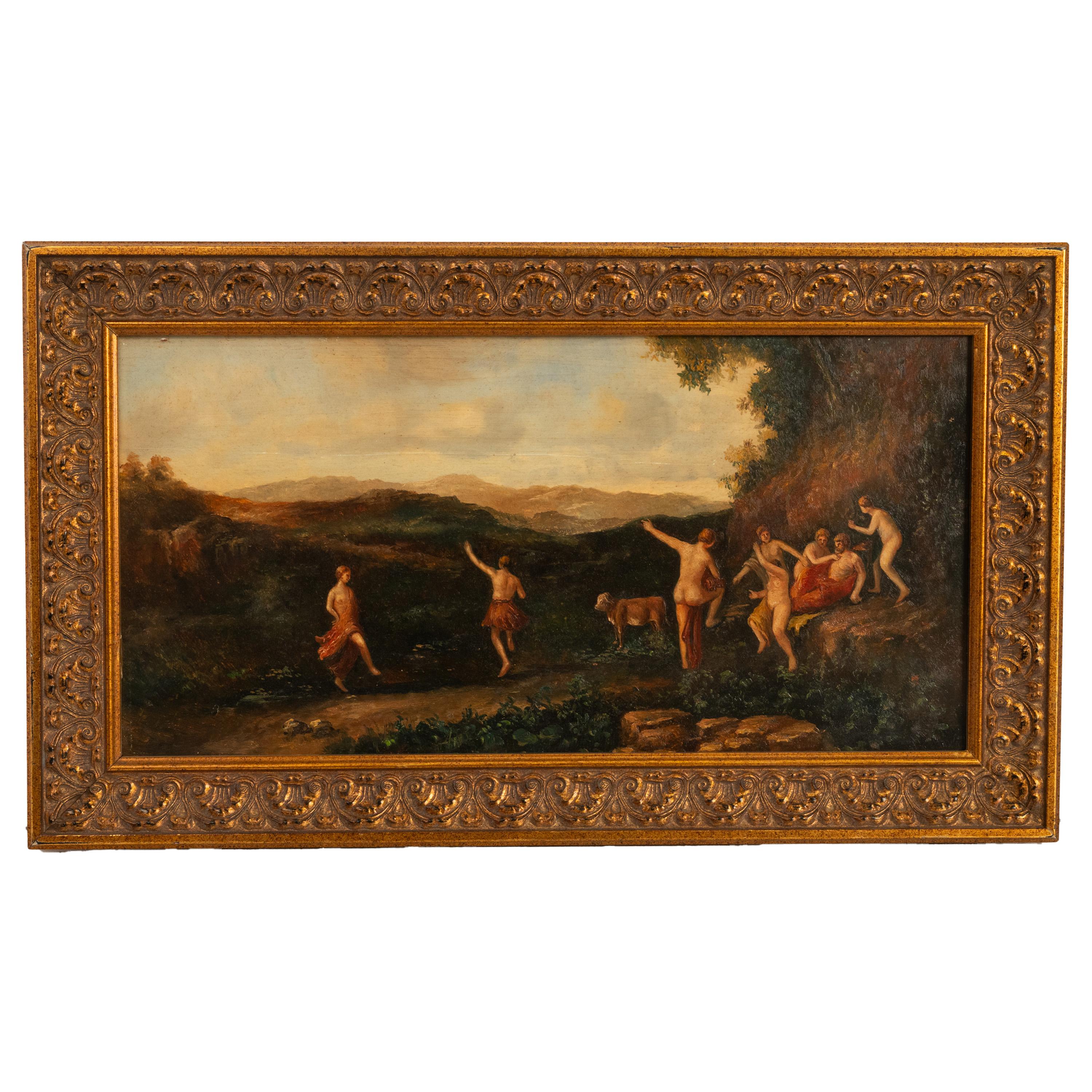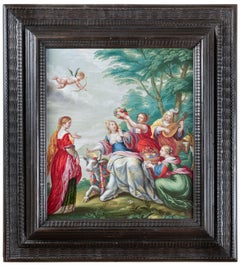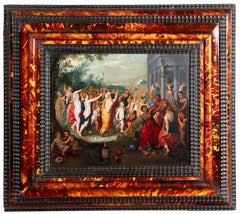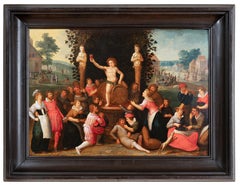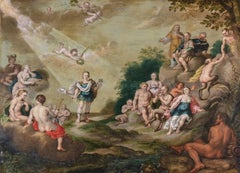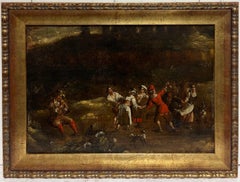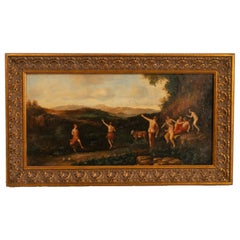Items Similar to The Musical Contest between Apollo and Marsyas, signed P. Sion, Antwerp 17th c.
Video Loading
Want more images or videos?
Request additional images or videos from the seller
1 of 13
Peter SionThe Musical Contest between Apollo and Marsyas, signed P. Sion, Antwerp 17th c.
$13,557.67
£10,297.39
€11,500
CA$19,030.42
A$20,782.69
CHF 10,909.14
MX$249,269.67
NOK 137,395.05
SEK 129,066.82
DKK 87,590.01
About the Item
The Musical Contest between Apollo and Marsyas,
by Peter Sion (Antwerp, 1624-1695)
Signed in the lower right corner P. Sion
17th century Antwerp School
Oil on copper, dim. h. 53 cm, w. 45 cm
Moulded and ebonized wood frame with wide mouldings, with reversed profile
Framed dimensions: h. 80 cm, w. 72 cm
Our work illustrates the musical contest between Apollo, god of music, and the satyr Marsyas. This mythological episode is recounted by the Roman poet Ovid in his Metamorphoses.
Taking place in a wooded landscape marked by shades of green and turquoise, the competition begins with Marsyas, seated on a rock and playing the flute. King Midas, seated in the middle, recognizable by his golden royal cape lined with ermine, is chosen to judge and designate the winner. He gestures towards the satyr. On the right, Apollo, standing, his lyre under his arm, partially dressed in a pink cloth, laurel crown on his head, points his index finger at his rival.
The scene chosen by Peter Sion illustrates the beginning of the competition, where Marsyas, confident, thinks he can win. In the rest of the story that Ovid tells us, Apollo challenges him to play by turning the instrument over, setting an example with his upside-down lyre. Unable to play the inverted flute, Marsyas loses and suffers the punishment of the god of music, he is flayed alive.
Our composition focusing on the first part of the story is endowed with a palette rich in intense colors, favored by the support (copper) which allows to obtain saturated colors and a better state of conservation than wood.
Peter Sion (Antwerp, 1624-1695)
Peter Sion was an Antwerp painter of landscapes, history paintings and genre scenes. His work was mainly intended for export and he mainly specialized in biblical subjects.
Born in Antwerp in 1624, registered in the Antwerp Guild of Saint Luke in 1636-37 as a pupil of Frans van Lanckvelt, he became a master in 1649, he worked in the workshop of Guillaume Forchondt, one of the most important exporters of Flemish works of art to all of Europe.
In 1682, he was appointed dean of the Guild of Saint Luke.
Peter Sion used copper as a support for the majority of his works. Biblical scenes being his favorite subject, his style is very close to the late Mannerism of Frans Francken and his workshop, with which his works are often confused. One of the characteristics of his work is the quality of the drawing as well as the significant space occupied by the figures in his compositions.
- Creator:Peter Sion (1624 - 1695, Belgian)
- Dimensions:Height: 31.5 in (80.01 cm)Width: 28.35 in (72.01 cm)
- Medium:
- Movement & Style:
- Period:
- Condition:excellent original condition, revarnished by our professional art restorer, ready to be hanged on the wall.
- Gallery Location:PARIS, FR
- Reference Number:1stDibs: LU2433215925032
About the Seller
No Reviews Yet
Vetted Professional Seller
Every seller passes strict standards for authenticity and reliability
1stDibs seller since 2023
17 sales on 1stDibs
- ShippingRetrieving quote...Shipping from: PARIS, France
- Return Policy
Authenticity Guarantee
In the unlikely event there’s an issue with an item’s authenticity, contact us within 1 year for a full refund. DetailsMoney-Back Guarantee
If your item is not as described, is damaged in transit, or does not arrive, contact us within 7 days for a full refund. Details24-Hour Cancellation
You have a 24-hour grace period in which to reconsider your purchase, with no questions asked.Vetted Professional Sellers
Our world-class sellers must adhere to strict standards for service and quality, maintaining the integrity of our listings.Price-Match Guarantee
If you find that a seller listed the same item for a lower price elsewhere, we’ll match it.Trusted Global Delivery
Our best-in-class carrier network provides specialized shipping options worldwide, including custom delivery.More From This Seller
View AllThe Rape of Europa, signed Peter Sion (1624-1695), Antwerp, 17th century
Located in PARIS, FR
The Rape of Europa
By Peter Sion (Antwerp, 1624-1695)
Signed in the lower right corner P. Sion
17th century Antwerp School
Oil on copper, dim. h. 53 cm, w. 45 cm
Moulded and ebonized...
Category
17th Century Old Masters Figurative Paintings
Materials
Oak, Oil, Wood Panel
The Triumph of the Infant Bacchus, workshop of H. Van Balen, 16th c. Antwerp
By Hendrick van Balen
Located in PARIS, FR
The Triumph of the Infant Bacchus,
Workshop of Hendrick Van Balen (1575-1632)
Antwerp, c.1630
Oil on copper, h. 28 cm (11.02 in), w. 35 cm (13.78 in)
A large Roman 17th century golden painted frame
Framed: h. 52 cm (20.47 in.), w. 58 cm (22.83 in)
Our finely painted work depicts The Triumph of the Bacchus as a young boy and is one of the most popular mythological subjects in Antwerp at the beginning of the 17th century. Feasting, wine and fun are the themes that constantly appeal to the public.
Thus unfolds before our eyes on our painting the procession composed of nymphs, baccantes, fauns, satyrs and children, their bodies naked, partially covered with brightly coloured draperies that help to brighten up the parade. Playing various instruments, dancing and drinking, while carrying vases and poles adorned with grapevines, participants to the rhythm of a noisy brass band make their way to an ancient temple standing on the right. The exaggerated gestures convey to us the frenzy of the excited crowd.
The Child Bacchus follows the joyous procession, carried by satyrs and nymphs, crowned with ivy and joyfully raising a cup of wine. In the foreground, the drunken participants leave the procession, the children on the left and the group of bacchantes and satyrs on the right are resting among various objects scattered at their feet: cups, vases, ewers bear witness to the festivities in progress.
In the background, a hilly landscape stretches out on the horizon, a semblance of calm that contrasts with the bustle of the foreground.
The artist strives to multiply the many details, whether it be figures, costumes, flowers or vegetation, in order to demonstrate his know-how and the perfection of his execution.
The acidulous palette with fresh and varied colours is characteristic of Hendrick Van Balen's works.
There are several versions identical to ours with similar dimensions painted by Hendrick Van Balen and his workshop.
Related works:
• Koller Auction, Zurich, 21/09/2007, oil on copper, 28,5 x 37,4 cm.
• Staatliche Kunsthalle, Karlsruhe, Inv. N° 809 (oil on copper, 40 x 53,5 cm)
• Auktionshaus für Altertümer Glückselig, Vienne, 10/05/1932, ( oil on copper, 34 x 42 cm)
• Gemäldegalerie of Pommersfelden, Schloss Weissenstein, oil on panel, 47 x 64 cm
Hendrick Van Balen, Flemish painter, born and died in Antwerp (1575-1632). A pupil of Adam Van Noort, he entered the Guild of St. Luke in 1593, later trained in Italy and was Van Dyck's first teacher. He often painted small figures taken from scenes from the Bible or classical mythology, on paintings whose backgrounds and landscapes were painted by Josse de Momper...
Category
17th Century Old Masters Figurative Paintings
Materials
Copper
Flemish 17th c., Allegory of war and peace, circa 1630, by Adriaen van Stalbemt
Located in PARIS, FR
Adriaen van Stalbemt (Antwerp, 1580-1662)
Allegory of Peace and War, circa 1620-1630
Oil on oak panel: h. 49.5 cm, l. 73.2cm (19.29 x 28.74 in)
Giltwood ...
Category
Early 17th Century Old Masters Figurative Paintings
Materials
Oil, Panel
Allegory of Autumn with Bacchus, studio of Louis de Caullery, 17th c. Antwerp
Located in PARIS, FR
Allegory of Autumn with worship of Bacchus
Studio of Louis de Caullery (Caullery, vers 1580 - Anvers, 1621/22)
17th century Antwerp school
Not signed
Oil on oak panel
Dimensions : p...
Category
Early 17th Century Old Masters Figurative Paintings
Materials
Oil, Wood Panel
Hieronymus FRANCKEN III - The Denial of Saint Peter, 17th c. Antwerp school
Located in PARIS, FR
Hieronymus FRANCKEN III (Antwerp 1611 - 1671)
17th century Antwerp School
The Denial of Saint Peter
Oil on panel, dim. h. 53 cm, l. 76 cm
Framed, h. 82 cm, l. 106 cm
Sold with the ...
Category
Mid-17th Century Old Masters Figurative Paintings
Materials
Oil, Wood Panel
Attributed à H. Francken II, 17th c. Anwerp - The prodigal son among courtesans
Located in PARIS, FR
The Prodigal Son Among Courtesans
Attributed to Hieronymus Francken II (Antwerp 1578-1623)
Early 17th century Antwerp school
Oil on oak panel,
Dimensions: H. 52.5 cm (20.67 in), W. 74 cm (29.14 in)
Flemish-style moulded wood frame
Frame: h. 78 cm (h. 30.70 in.), w. 100 cm (39.37 in.)
At first glance, this festive and joyful painting depicts a group of elegantly dressed people dancing to the sound of an orchestra in a richly decorated interior with a wide opening onto a rural exterior. However, the real theme is cleverly concealed by the painter and is only discernible through the artifice of a small scene in the background where we see a half-naked man, in the company of the pigs next to a makeshift shelter.
In fact, beyond the pleasant and apparently superficial character of the painting, it is a subject taken from the parable of the prodigal son in the Gospel. The illustrated episode is the prodigal son among courtesans.
Even if the viewer's attention is drawn to the central couple (prodigal son embracing a pretty courtesan) doing the dance steps, the artist takes care in a narrative approach of all the groups and ancillary scenes in order to create a rich and varied composition. Thus the musicians seated on a raised platform are depicted with great skill, their faces animated, their clothes abundantly varied.
The theme of music, which has always been associated with that of sensuality and physical love, helps to exacerbate licentious pleasures.
The merry company dances "Spanish pavane", a slow court dance from the sixteenth century, danced close to the ground by couples arranged in a procession, which was probably introduced to the south of the Netherlands around 1600 during the governance of Albrecht VII and the daughter of the King of Spain Isabella Clara Eugenia in Brussels.
The interior of the house is also carefully elaborated, the embossed leather dyes on the walls, the middle sideboard (typical in Francken interiors), where the rich gold and silver crockery is placed in front of the painting "Andromeda chained to the rock and Perseus arriving to rescue her". The inclusion of a contemporary and probably extant pictorial work is also one of the characteristics of the Francken family, among them Frans Francken the Younger...
Category
Early 17th Century Old Masters Interior Paintings
Materials
Oak, Oil
You May Also Like
'The Music Contest between Apollo and Pan', Renaissance Mythology, Satyr, Hermes
By Flemish School, 17th Century
Located in Santa Cruz, CA
An early 17th-century Flemish School oil on copper showing the mythological contest between Apollo and Pan in which the mountain god, Tmolus, gives judgement for Apollo. Unsigned. Pa...
Category
Early 17th Century Northern Renaissance Figurative Paintings
Materials
Copper
17th Century Flemish Old Master Dancing Figures Musicians Antique Oil Painting
Located in Cirencester, Gloucestershire
Dancing Figures
Flemish School, 17th century
oil on on canvas, framed
framed: 21.5 x 28.5 inches
canvas : 16.5 x 24 inches
Provenance: private collection, France
Condition: very good...
Category
17th Century Baroque Figurative Paintings
Materials
Oil
$2,444 Sale Price
30% Off
Antique 19th Century Neoclassical Bacchanal Painting Dancing of the Nymphs 1850
By Cornelius van Poelenburgh
Located in Portland, OR
A good antique Dutch/Flemish oil on panel painting, after Cornelis van Poelenburgh, circa 1850.
The painting portrays a number of nude and par...
Category
Mid-19th Century Old Masters Figurative Paintings
Materials
Oil, Panel
The Preaching of St. John the Baptist, Workshop of Fans Francken II, 1600s
Located in Milan, IT
The sermon of the Baptist is set in a large open space, with rich vegetation and wooded glimpses, and on the back, in the distance, you can see the buildings of a city.
The scene see...
Category
17th Century Other Art Style Figurative Paintings
Materials
Oil
Thomas Willeboirts Bosschaert, Dancing Putti, Pan, Satyr, Rubens School, Model
By Thomas Willeboirts Bosschaert
Located in Greven, DE
Thomas Willeboirts Bosschaert
Pan plays to the dance of the putti
Thomas Willeboirts Bosschaert (1614 Bergen op Zoom - 1654 Antwerp)
Pan plays to the dance of the putti
Oil sketch
Oil on canvas, 35 x 51 cm
Provenance:
Belgian private collection, ca. 1980 to 2020.
The oil sketch shows a flute-playing man with dark curls sitting at the left edge
of the picture in a recess draped with cloth. In the lower left corner, a fallen
bowl with leaking water can be seen. The right half of the picture shows a circle
of five dancing putti, whereby the left putti can be recognized as a satyr due to
the goat legs. The background is dominated by a dark mountain landscape. In
the sky a rising or setting sun can be guessed. It is possible that the flute player
represents Bacchus, the god of wine and ecstasy. This fits with the flute as a
symbol of celebration, as well as the bowl of water, which could refer to
Bacchus' mother, Lethe. Lethe is a river in the underworld, which at the same
time symbolizes "oblivion". Thus, the spilling water bowl is not only a reference
to this river, but it also symbolizes "oblivion". Moreover, Bacchus is usually
depicted with satyrs in his retinue, which would explain the putto with goat legs.
However, the interpretation of the flute player as the god Pan would be
possible. He is usually shown with his flute and associated with dance.
Moreover, he is native to the mountainous landscape of Arcadia.
The present work is an oil sketch, i.e. a preparatory study. This is suggested by
the partly unfinished parts, as well as the structure of the picture. Some parts
are already almost completely laid out, such as the flute player, while others, for
example the horizon and also the figures of the putti, are only sketched in
outline.
The painting can be attributed to the Baroque painter Thomas Willeboirts
Bosschaert. This attribution was also confirmed by Prof. Hans Vlieghe.
Bosschaert lived and worked in Antwerp with Peter Paul Rubens and Anthonis
van Dyck, among others. He studied with Gerard Seghers...
Category
17th Century Baroque Figurative Paintings
Materials
Canvas
Large 17th Century Flemish Old Master Oil Painting Resurrection of Lazarus
Located in Cirencester, Gloucestershire
The Resurrection of Lazarus
Flemish Old Master, 17th century
(unsigned as is typical for the period)
oil on canvas, framed
framed: 30 x 38 inches
canvas: 19 x 27 inches
Provenance: ...
Category
17th Century Baroque Figurative Paintings
Materials
Oil
$11,938 Sale Price
30% Off
More Ways To Browse
Apollo Art
Plays The Flute
17th Century Copper
Laurel Crown
17th Century Oak Panels
Oil Painting Signed Peter
Master Apollo
Ermine Cape
Francesco Albani
Girl In Pink Dress
Hockey Painting
Indian Dance Painting
Jacques Doucet
London Transport Museum Vintage Posters
Melissa Hefferlin
Michelangelo Pieta
Mike Carson
Musketeer Oil
